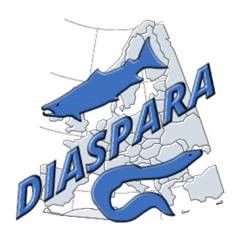The DIASPARA project aims to improve the management of salmon and eel in Europe by strengthening the scientific knowledge base over the full life-cycle and geographic range of these migratory species.
Atlantic salmon and European eel migrate long distances in their lifetime, often moving between multiple countries over the course of their lives. This creates challenges for the management of these species, as both the natural and human impacts that they experience can differ greatly between these different areas, and can be hard to fully quantify.
Protecting Atlantic Salmon and European Eel: A call for regional and international cooperation
Despite legal commitments for their conservation, the Atlantic salmon and the European eel are currently endangered. This is partly due to their ecological characteristics, where the two species share their life cycle between marine and river ecosystems, in and outside Europe. This wide distribution makes them susceptible to many diverse human impacts (e.g. fisheries, habitat degradation and fragmentation, pollution). Furthermore, the use of both marine and river habitats over the course of their lives means that the impacts experienced by any one fish can differ greatly from those experienced by another. In rivers, natural and human impacts are unique to that given river, meaning that different fish from the same species can experience widely different natural and human impacts if they spend their freshwater phase in different rivers. However, during their marine phase, fish from different rivers mix and share the same natural and human impacts. Proper management for such a life history requires cooperation on both a regional and international scale, collecting and interpreting data over the full range of the species, and taking into account the different impacts experienced in different areas.
Main objectives
In this context, the DIASPARA project aims to improve upon the management of Atlantic salmon and European eel by helping to provide the tools necessary to create complete assessment models that are based on data collected from the full range of these species. For this, DIASPARA will address three main objectives:
- Optimise data collection and usage, and enhancing knowledge. Data on for instance growth, maturation, and survival changes both between different regions, as well as between different times. DIASPARA will make an inventory of this available data and analyse the patterns in both time and space, across the species ranges. In doing so, the project will look for changes over time, and for different trends across different regions, to improve the use of this data in stock assessment models. Furthermore, DIASPARA will use these results to advise on future improvements to data collection.
- Optimise data availability, by promoting international coordination in data storage. For many European marine fish stocks, data that is needed for their management is stored in databases that are hosted and maintained by ICES (International Council for the Exploration of the Seas), an intergovernmental organisation that provides scientific advice on the management of fish stocks. However, these databases are not well suited to handle the diversity of the habitats and of human impacts across these different habitats, which characterises the data of salmon and eel. As such, data for salmon and eel are currently stored in locally-hosted databases that are “home-made” by the expert groups of scientists that have worked on scientific advice for these species. DIASPARA will develop database structures specifically designed for any migratory fish species, which are able to handle the full spatial spread of data, as well as the diversity of impacts that each species faces.
- Move towards improving the stock assessment models that support management advice. Stock assessment methods for migratory species such as Atlantic salmon and European eel should be able to explicitly handle the complex spatial structure and the life cycle characteristics of the species. This results in complex and time-consuming models for salmon, and has so far prevented the development of any single whole-stock assessment model for eel. DIASPARA will analyse different tools and statistical assumptions for the existing salmon models, to improve their performance. Furthermore, DIASPARA will evaluate new knowledge and methods for incorporating changes in growth, survival, and maturity over time and space into stock assessment models, aiming to further improve upon existing salmon models and helping to lay the foundation for a first full-stock model for eel.

Financing
The DIASPARA (DIAdromous Species: moving towards new PARadigms to achieve holistic scientific Advice) project is funded through an EMFAF (European Maritime, Fisheries and Aquaculture Fund) Project Grant (call EMFAF-2023-PIA-FisheriesScientificAdvice, Project number: 101155914), together with co-funding from all participating institutes.
The EU is not responsible for the content of the projec



